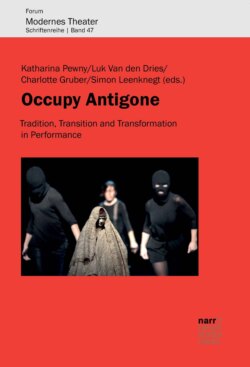Читать книгу Occupy Antigone - Группа авторов - Страница 11
На сайте Литреса книга снята с продажи.
3. Brecht’s deinon
ОглавлениеBrecht’s method of adapting Sophocles/Hölderlin for the stage, in what he officially called The Antigone of Sophocles; A version for the stage after Hölderlin’s translation, is based on diametrically opposite premises, recognizing the hermeneutical heritage of the text instead of Heidegger’s open and even violent resistance to this humanistic heritage. Thus, instead of violating the translation of deinon as ungeheuer, Brecht accepts this option. In the English translation of Brecht’s adaptation of the Hölderlin version of the “Ode to Man”, translated by David Constantine, who has also translated Hölderlin’s German translations of Antigone as well as of Oedipus the King into English, ungeheuer is “monstrous”.
Monstrous [ungeheuer], a lot. But nothing
More Monstrous than man.
For he across the night
Of the sea, when into the winter
the Southerlies blow, he puts out
In winged and whirring houses.1
Brecht follows Hölderlin’s translation of the “Ode to Man” until the end of the second strophe, where the chorus says that even if man’s resources are seemingly infinite, there is one thing he cannot escape, and that is death. Hölderlin’s German translation, again with a strong negative, is "Allbewandert. / Unbewandert. Zu nichts kommt er", which Constantine translates as "All-travelled / Untravelled. He comes to nothing".2 And to give a brief impression of how condensed Hölderlin’s translation is, the Penguin Classics translation by Robert Fagles of this crucial passage in Antigone has thirty instead of the six words. The "Allbewandert. / Unbewandert. Zu nichts kommt er" of Hölderlin in this English translation is:
Never without resources
never an impasse as he marches on the future –
only Death, from Death alone he will find no rescue
but from desperate plagues he has plotted his escapes.3
But at this point, where the second antistrophe begins, Brecht (as his own name indicates) literally breaks away from his Vorlage (source or prototype). The first sentence of Hölderlin’s version of the second antistrophe (in English) is more like an adaptation of Sophocles’ text than the other sections of his translation of the “Ode to Man”:
[Only the future place of the dead
He does not know how to flee
Nor to think of a way
Of flight from clumsy plagues.]
Possessing something
More than he hopes of wisdom and the skills of art
He comes to grief one time and to good another.4
And here is Brecht’s version of the second antistrophe, where the chorus points at itself and at man (and here the male gender is appropriate) as his own enemy:
Always he knows what to do
Nothing nonplusses him.
In all this he is boundless but
A measure is set.
For when he wants for an enemy
He rises up as his own.
[…]
By himself alone
His belly will never be filled but he builds a wall
Around what he owns and the wall
Must be torn down. The roof
Opened to the rain. Humanity
Weighs with him not a jot. Monstrous thereby
He becomes to himself. 5
Brecht is gradually working towards the paradoxical definition of man as he who becomes monstrous to himself, or in the German – "So, ungeheur / Wird er sich selbst" – which with its compressed reflexivity, projects a mirror of monstrosity where man can view how he becomes his own enemy and destroyer.
This detailed textual analysis is crucial in order to understand how the logical arguments are constructed, and these logical arguments are in turn necessary in order to grasp which principles a certain translation, adaptation, staging or interpretation has applied, how it is constituted and how a specific reading, in spite of its potential contradictions progresses towards some form of poetic or aesthetic consistency.
But this is not sufficient. With regard to Heidegger’s ’reading’, we still need to learn more about how deinon appropriates and disposes that which is not violent and expresses itself through what he terms “a seeking and searching out the homely, a seeking that at times does not know itself”, totally annihilating Antigone’s subject position. His approach is based on an unrestrained use of force and violence which, using Heidegger’s own metaphor, he believes can actually "set us upon the path of ascent towards the peak".
And with regard to Brecht it is important to note that even before his production of Antigone, already in his Lehrstücke (The Learning Plays), which were composed prior to his exile after Hitler’s takeover of political power in 1933, Brecht had already explored the notion that tragedy shows how man becomes his own enemy. At that time – as he was writing the Lehrstücke – the thinking of Walter Benjamin, in particular as developed in his essay " Critique of Violence", from 1921, and his book on the Trauerspiel, the German mourning play, from 1928, as well as their close personal contacts were no doubt of great importance.
When working on his production of Antigone in 1948, after the Second World War, trying to answer the question what Antigone "can do for us", Brecht’s adaptation of the "Ode to Man" was, I believe, carried out with the hope (or perhaps even conviction) that the monstrosity of human actions can be controlled by the awareness that man has transformed himself into his own enemy, becoming monstrous (ungeheuer) to himself.
